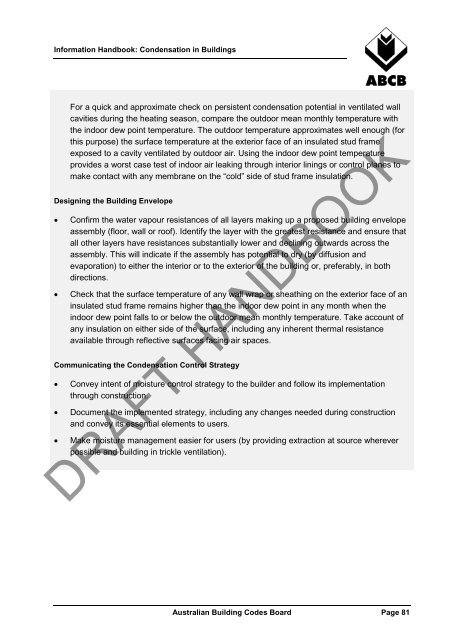Condensation in Buildings - Australian Building Codes Board
Condensation in Buildings - Australian Building Codes Board
Condensation in Buildings - Australian Building Codes Board
You also want an ePaper? Increase the reach of your titles
YUMPU automatically turns print PDFs into web optimized ePapers that Google loves.
Information Handbook: <strong>Condensation</strong> <strong>in</strong> Build<strong>in</strong>gs<br />
For a quick and approximate check on persistent condensation potential <strong>in</strong> ventilated wall<br />
cavities dur<strong>in</strong>g the heat<strong>in</strong>g season, compare the outdoor mean monthly temperature with<br />
the <strong>in</strong>door dew po<strong>in</strong>t temperature. The outdoor temperature approximates well enough (for<br />
this purpose) the surface temperature at the exterior face of an <strong>in</strong>sulated stud frame<br />
exposed to a cavity ventilated by outdoor air. Us<strong>in</strong>g the <strong>in</strong>door dew po<strong>in</strong>t temperature<br />
provides a worst case test of <strong>in</strong>door air leak<strong>in</strong>g through <strong>in</strong>terior l<strong>in</strong><strong>in</strong>gs or control planes to<br />
make contact with any membrane on the “cold” side of stud frame <strong>in</strong>sulation.<br />
Design<strong>in</strong>g the Build<strong>in</strong>g Envelope<br />
• Confirm the water vapour resistances of all layers mak<strong>in</strong>g up a proposed build<strong>in</strong>g envelope<br />
assembly (floor, wall or roof). Identify the layer with the greatest resistance and ensure that<br />
all other layers have resistances substantially lower and decl<strong>in</strong><strong>in</strong>g outwards across the<br />
assembly. This will <strong>in</strong>dicate if the assembly has potential to dry (by diffusion and<br />
evaporation) to either the <strong>in</strong>terior or to the exterior of the build<strong>in</strong>g or, preferably, <strong>in</strong> both<br />
directions.<br />
• Check that the surface temperature of any wall wrap or sheath<strong>in</strong>g on the exterior face of an<br />
<strong>in</strong>sulated stud frame rema<strong>in</strong>s higher than the <strong>in</strong>door dew po<strong>in</strong>t <strong>in</strong> any month when the<br />
<strong>in</strong>door dew po<strong>in</strong>t falls to or below the outdoor mean monthly temperature. Take account of<br />
any <strong>in</strong>sulation on either side of the surface, <strong>in</strong>clud<strong>in</strong>g any <strong>in</strong>herent thermal resistance<br />
available through reflective surfaces fac<strong>in</strong>g air spaces.<br />
Communicat<strong>in</strong>g the <strong>Condensation</strong> Control Strategy<br />
• Convey <strong>in</strong>tent of moisture control strategy to the builder and follow its implementation<br />
through construction.<br />
• Document the implemented strategy, <strong>in</strong>clud<strong>in</strong>g any changes needed dur<strong>in</strong>g construction<br />
and convey its essential elements to users.<br />
• Make moisture management easier for users (by provid<strong>in</strong>g extraction at source wherever<br />
possible and build<strong>in</strong>g <strong>in</strong> trickle ventilation).<br />
DRAFT HANDBOOK<br />
<strong>Australian</strong> Build<strong>in</strong>g <strong>Codes</strong> <strong>Board</strong> Page 81
















